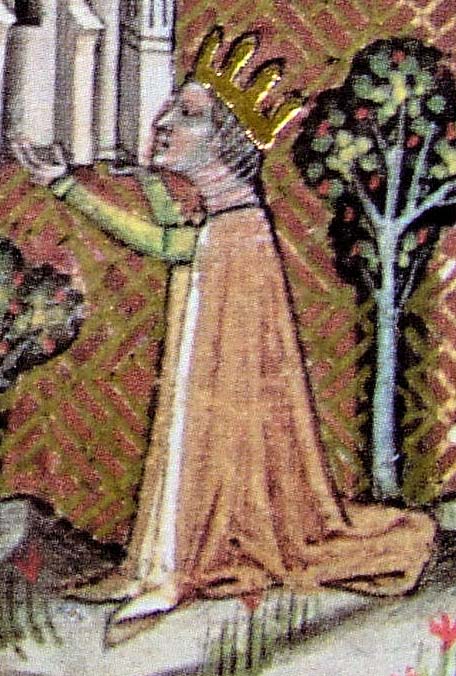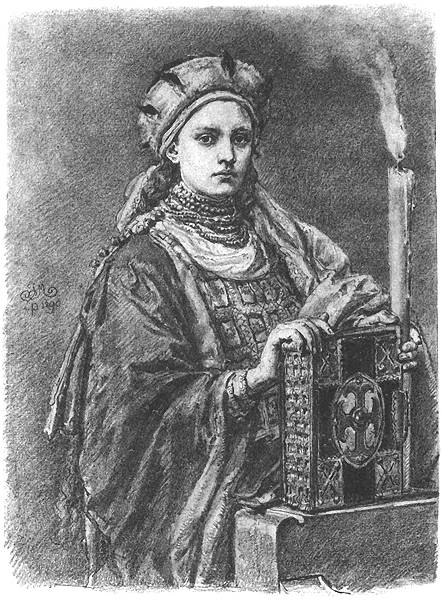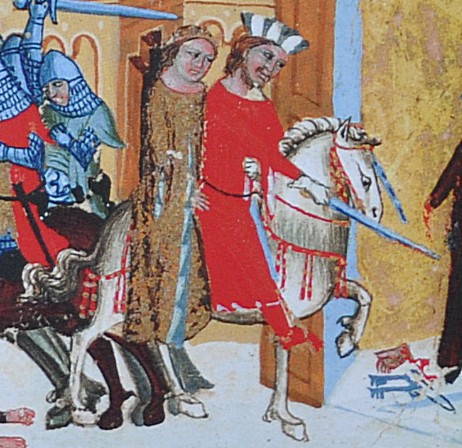|
Elisabeth Of Bosnia
Elizabeth of Bosnia ( sh-Latn-Cyrl, separator=/, Elizabeta Kotromanić, Елизабета Котроманић; hu, Kotromanics Erzsébet; pl, Elżbieta Bośniaczka; – January 1387) was queen consort of Hungary and Croatia, as well as queen consort of Poland, and, after becoming widowed, the regent of Hungary and Croatia between 1382 and 1385 and in 1386. Daughter of Ban Stephen II of Bosnia, Elizabeth became Queen of Hungary upon marrying King Louis I the Great in 1353. In 1370, she gave birth to a long-anticipated heir, Catherine, and became Queen of Poland when Louis ascended the Polish throne. The royal couple had two more daughters, Mary and Hedwig, but Catherine died in 1378. Initially a consort with no substantial influence, Elizabeth then started surrounding herself with noblemen loyal to her, led by her favourite, Nicholas I Garai. When Louis died in 1382, Mary succeeded him with Elizabeth as regent. Unable to preserve the personal union of ... [...More Info...] [...Related Items...] OR: [Wikipedia] [Google] [Baidu] |
Queen Consort Of Hungary
This is a list of the queens consorts of Hungary ( hu, királyné), the consorts of the kings of Hungary. After the extinction of the Árpád dynasty and later the Angevin dynasty, the title of King of Hungary has been held by a monarch outside of Hungary with a few exceptions. After 1526, the title of Queen of Hungary belonged to the wife of the Habsburg Emperors who were also King of Hungary. Queens of Hungary also held the titles after 1526: Holy Roman Empress (later Empress of Austria) and Queen consort of Bohemia. Since Leopold I, all kings of Hungary used the title of Apostolic King of Hungary the title given to Saint Stephen I by the Pope and their wives were styled as Apostolic Queens of Hungary. The title lasted just a little over nine centuries, from 1000 to 1918. The Kingdom of Hungary also had two queens regnant (''királynő'') who were crowned as kings: Maria I and Maria II Theresa. Grand Princesses of the Hungarians Queens consort of Hungary House ... [...More Info...] [...Related Items...] OR: [Wikipedia] [Google] [Baidu] |
John Of Palisna
John of Palisna ( hr, Ivan od Paližne, la, Joannes de Palisna) (? – 23 March 1391) was a Croatian knight and warrior, prior of Vrana, and Ban of Croatia. Prior of Vrana It is unclear when John of Palisna became prior of Vrana.Hunyadi and Laszlovszky (2001), pp. 285–290. In May 1381 he was already prior, because the citizens of Zadar were complaining about him to the King of Hungary and Croatia. He co-ruled with relative Ivan (John) Anjou Horvat de Radics as a Ban of Croatia from 1385 to 1386, and in 1389. In 1389, groups of crusaders linked to the Knights Hospitaller under a ''Domine Johanne Bano'' are mentioned as fighting in the battle of Kosovo in Annales Forolivienses. ''Domine Johanne Bano'' most probably refers to John of Palisna, although identification with a John Horvat has also been proposed. In the same year, John lost one of his last strongholds in Croatia, the Klis Fortress. Without the help from the Kingdom of Bosnia, John was unable to resist Sigismu ... [...More Info...] [...Related Items...] OR: [Wikipedia] [Google] [Baidu] |
John Horvat
John Horvat ( hr, Ivan Horvat; hu, Horváti János; died on 15 August 1394) was a Croato– Hungarian nobleman in the Kingdom of Hungary-Croatia who served as Ban of Macsó from 1376 to 1381, and again between 1385 and 1386. Horvat was the brother of Ladislaus and Paul, Bishop of Zagreb, and nephew of John of Palisna. Together with his uncle, Horvat led the uprising against Queen Mary and her mother and regent, Elizabeth of Bosnia. He assisted King Charles III of Naples in deposing Mary and assuming the Hungarian crown in late 1385. Queen Elizabeth soon had Charles murdered. In 1386, Horvat and his uncle captured the queens in Gorjani and imprisoned them. Elizabeth was strangled on the orders of Horvat's uncle, while Mary was eventually released by her husband, Sigismund of Luxembourg, who had recently been crowned king of Hungary. Horvat's ally was Elizabeth's first cousin, King Tvrtko I of Bosnia, who appointed him and his brothers governors of Usora. Horvat himself was ... [...More Info...] [...Related Items...] OR: [Wikipedia] [Google] [Baidu] |
Polish Throne
Poland was ruled at various times either by dukes and princes (10th to 14th centuries) or by kings (11th to 18th centuries). During the latter period, a tradition of free election of monarchs made it a uniquely electable position in Europe (16th to 18th centuries). The first known Polish ruler is Duke Mieszko I, who adopted Christianity under the authority of Rome in the year 966. He was succeeded by his son, Bolesław I the Brave, who greatly expanded the boundaries of the Polish state and ruled as the first king in 1025. The following centuries gave rise to the mighty Piast dynasty, consisting of both kings such as Mieszko II Lambert, Przemysł II or Władysław I the Elbow-high and dukes like Bolesław III Wrymouth. The dynasty ceased to exist with the death of Casimir III the Great in 1370. In the same year, the Capetian House of Anjou became the ruling house with Louis I as king of both Poland and Hungary. His daughter, Jadwiga, later married Jogaila, the pagan Grand Duke ... [...More Info...] [...Related Items...] OR: [Wikipedia] [Google] [Baidu] |
Union Of Hungary And Poland
__NOTOC__ Personal union between the Kingdom of Hungary and the Kingdom of Poland was achieved twice: under Louis I of Hungary, in 1370–1382, and under Władysław III of Poland in 1440–1444. An earlier union was also accomplished by Wenceslaus III of Bohemia for a few months in 1305, although he was heavily resisted by local nobles in both kingdoms, and gave up the Hungarian crown soon after. Angevin union The first union came about when the last Piast king of Poland, Casimir III, designated his sororal nephew, the Angevin king Louis I of Hungary, as his heir presumptive by the Privilege of Buda. Upon the death of Casimir, who left no legitimate sons, Louis ascended the Polish throne virtually unopposed. The Polish nobility welcomed his accession, rightly believing that Louis would be an absentee king who would not take much interest in Polish affairs. He sent his mother Elizabeth, sister of Casimir III, to govern Poland as regent. Louis probably considered himself first an ... [...More Info...] [...Related Items...] OR: [Wikipedia] [Google] [Baidu] |
Personal Union
A personal union is the combination of two or more states that have the same monarch while their boundaries, laws, and interests remain distinct. A real union, by contrast, would involve the constituent states being to some extent interlinked, such as by sharing some limited governmental institutions. Unlike the personal union, in a federation and a unitary state, a central (federal) government spanning all member states exists, with the degree of self-governance distinguishing the two. The ruler in a personal union does not need to be a hereditary monarch. The term was coined by German jurist Johann Stephan Pütter, introducing it into ''Elementa iuris publici germanici'' (Elements of German Public Law) of 1760. Personal unions can arise for several reasons, such as: * inheritance through a dynastic union, e.g. Louis X of France inherited France from his father and Navarre from his mother * decolonization, ex-colonies install the monarch of the former colonizing power as ... [...More Info...] [...Related Items...] OR: [Wikipedia] [Google] [Baidu] |
Nicholas I Garai
Nicholas I Garai ( hu, Garai I Miklós, hr, Nikola I Gorjanski) (''c.'' 132525 July 1386) was a most influential officeholder under king Louis I and queen Mary of Hungary. He was ban of Macsó between 1359 and 1375, and palatine from 1375 until his death. He was also ''ispán'' or head of a number of counties over his lifetime. Early life Son of Andrew Garai and his wife (an unknown daughter of Ladislaus Nevnai), Nicholas Garai was born around 1325. His uncle, Pál Garai ('' ban'' of Macsó between 1320 and 1328) was a leading baron under kings Charles I and Louis I of Hungary. Nicholas's career in politics started under Louis I who appointed him to administer the Banate of Macsó in 1359. As ''ban'' of Macsó, Nicholas also became the head of Bács, Baranya, Szerém, Valkó and Veszprém counties. The influential baron Garai launched, in 1369, a punitive expedition against Vladislav I of Wallachia who had rebelled against King Louis I and defeated a royal army led by Nic ... [...More Info...] [...Related Items...] OR: [Wikipedia] [Google] [Baidu] |
Favourite
A favourite (British English) or favorite (American English) was the intimate companion of a ruler or other important person. In post-classical and early-modern Europe, among other times and places, the term was used of individuals delegated significant political power by a ruler. It was especially a phenomenon of the 16th and 17th centuries, when government had become too complex for many hereditary rulers with no great interest in or talent for it, and political institutions were still evolving. From 1600 to 1660 there were particular successions of all-powerful minister-favourites in much of Europe, particularly in Spain, England, France and Sweden. The term is also sometimes employed by writers who want to avoid terms such as "royal mistress", "friend", "companion", or "lover" (of any gender). Several favourites had sexual relations with the monarch (or the monarch's spouse), but the feelings of the monarch for the favourite ran the gamut from simple faith in the favourite's ... [...More Info...] [...Related Items...] OR: [Wikipedia] [Google] [Baidu] |
List Of Polish Consorts
The wives of the rulers of the Kingdom of Poland were duchesses or queens consort of Poland. Two women ruled Poland as queens regnant, but their husbands were kings ''jure uxoris''. Wives of early Polish monarchs Duchesses of the Polans Queens and High Duchesses of Poland Piast Dynasty (1) Přemyslid Dynasty Piast Dynasty (2) Angevin Dynasty Jagiellon Dynasty Royal consort of the Polish–Lithuanian Commonwealth *Elżbieta Szydłowska (1748–1810) was the lover of King Stanisław August. Some believe that she married the King of Poland in 1783, but their marriage was morganatic, so she wasn't Queen of Poland. However, there is no known reason for the marriage to have been morganatic, as Poniatowski's Pacta conventa required him to marry a Polish noblewoman, a requirement she satisfied, and there is no evidence that the marriage ever occurred. According to Wirydianna Fiszerowa, a contemporary who knew them both, the rumour only arose after the ... [...More Info...] [...Related Items...] OR: [Wikipedia] [Google] [Baidu] |
List Of Hungarian Consorts
This is a list of the queens consorts of Hungary ( hu, királyné), the consorts of the kings of Hungary. After the extinction of the Árpád dynasty and later the Angevin dynasty, the title of King of Hungary has been held by a monarch outside of Hungary with a few exceptions. After 1526, the title of Queen of Hungary belonged to the wife of the Habsburg Emperors who were also King of Hungary. Queens of Hungary also held the titles after 1526: Holy Roman Empress (later Empress of Austria) and Queen consort of Bohemia. Since Leopold I, all kings of Hungary used the title of Apostolic King of Hungary the title given to Saint Stephen I by the Pope and their wives were styled as Apostolic Queens of Hungary. The title lasted just a little over nine centuries, from 1000 to 1918. The Kingdom of Hungary also had two queens regnant (''királynő'') who were crowned as kings: Maria I and Maria II Theresa. Grand Princesses of the Hungarians Queens consort of Hungary House ... [...More Info...] [...Related Items...] OR: [Wikipedia] [Google] [Baidu] |
Banate Of Bosnia
The Banate of Bosnia ( sh, Banovina Bosna / Бановина Босна), or Bosnian Banate (''Bosanska banovina'' / Босанска бановина), was a medieval state based in what is today Bosnia and Herzegovina. Although Hungarian kings viewed Bosnia as part of Hungarian Crown Lands, the Banate of Bosnia was a ''de facto'' independent state, for most of its existence. It was founded in the mid-12th century and existed until 1377 with interruptions under Šubić family between 1299 and 1324. In 1377 it was elevated to kingdom. The greater part of its history was marked by a religiopolitical controversy revolving around the native Christian Bosnian Church condemned as heretical by the dominant Nicene Christian churches, namely the Roman Catholic and Eastern Orthodox, with the Catholic church being particularly antagonistic and persecuting its members through the Hungarians. Historical background In 1136, Béla II of Hungary invaded upper Bosnia for the first time and cr ... [...More Info...] [...Related Items...] OR: [Wikipedia] [Google] [Baidu] |





